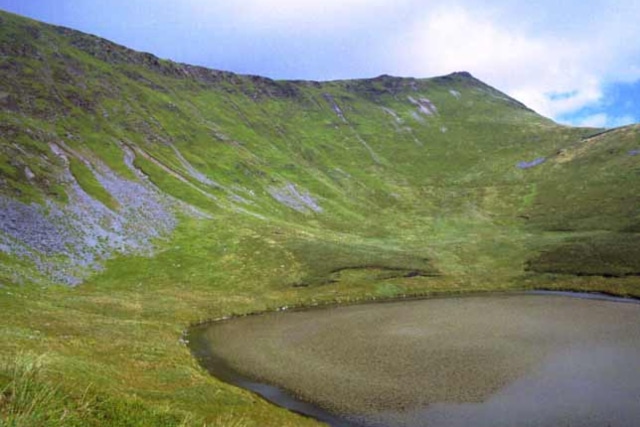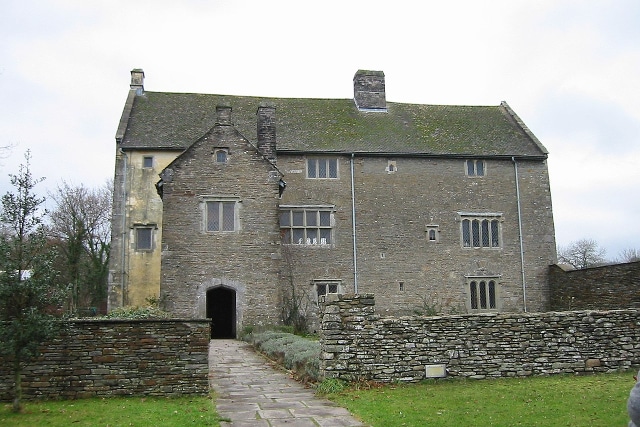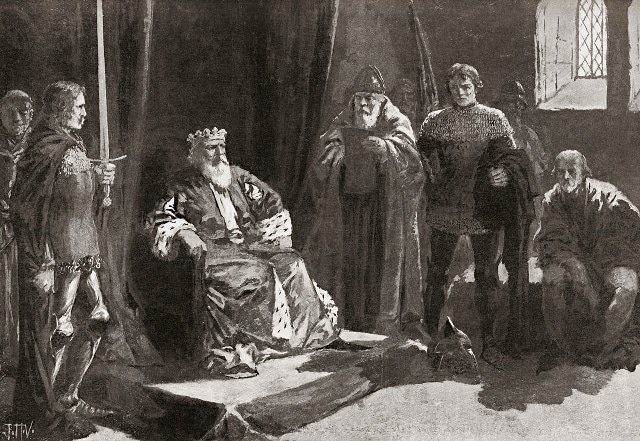We bring you the latest installment in our series where we explore a country’s past to discover some of the strangest mysteries, legends, and paranormal phenomena that it has to offer. Today, we take a look at Wales.
10. The Vanishing of Richey Edwards
https://www.youtube.com/watch?v=liPiwcmA_YU&ab_channel=RockN%27RollTrueStories
We start off with a mystery that has endured in the music world for over 25 years – what happened to Richey Edwards, the Welsh musician who disappeared without a trace on February 1, 1995?
Born in Blackwood in the South Wales Valleys, Edwards joined the rock group Manic Street Preachers in 1992, a group that went on to become an integral part of the Cool Cymru Welsh movement of the 90s. Then, in early 1995, on the day that he was supposed to fly to the U.S. on a promotional tour, the 27-year-old checked out of his hotel in London, drove to Wales and was never seen again.
The most common theory suggests that Edwards killed himself by jumping off the Severn Bridge, which connects England and Wales. His car was found abandoned at a nearby gas station a few weeks later, but his body has never been recovered, nor has there been any solid evidence that he committed suicide.
Richey Edwards was declared legally dead in 2008, but given the circumstances, not everyone is convinced this is true. Some people, including his sister, believe that Richey orchestrated his disappearance. Sightings of the musician have been reported, going as far as the Indian state of Goa. Furthermore, a new book about Edwards, written with his sister’s cooperation, claims that he had been fascinated with the idea of disappearing since his school days.
9. What Happened at the Berwyn Mountains?

On January 23, 1974, the people living near the Berwyn Mountains in the north of Wales were treated to a unique and mysterious event which included loud noises and bright lights traveling through the sky. For some people, the explanation was obvious – a UFO. This episode became immediately compared to the more famous Roswell incident in America, and is still sometimes referred to as the “Roswelsh” incident.
The event was investigated by the Ministry of Defence, and the report was finally declassified in 2010. It mentioned that a search & rescue team deployed by the Royal Air Force were not able to find a wreckage in the mountains. It concluded that the alleged UFO incident was actually caused by two separate events occurring at the same time. The lights in the sky were from a meteor, while the noises were created by an earthquake that caused a landslide.
The unlikely pairing of the two has not convinced everyone, and some true believers are still certain that the government covered up the crash of an alien spaceship.
8. Teggie, the Bala Lake Monster
If Berwyn Mountain can be seen as the Welsh Roswell, then Teggie is their version of the Loch Ness Monster. Allegedly found at Bala Lake in Gwynedd County, this creature takes its moniker from the Welsh name of the lake, Llyn Tegid, and is considered shy and elusive, even by sea monster standards. The last time it was supposedly caught on film was in 1976, and when a Japanese film crew brought their own minisubmarine to the lake in the 90s, they were unable to find any traces of the mysterious creature.
The legend of Teggie was enhanced by fishermen, who have reported sightings of the sea monster ever since the 1920s. Usually, it is described as a crocodile in appearance, at least 8 ft long, and has received the blame for many boating accidents that have occurred on the lake.
New sightings of Teggie are still being reported, but it still remains far more obscure than its Scottish cousin. This can be attributed chiefly to the locals, who aren’t very keen on having a sea monster, since watersports represent their main tourist attraction.
7. The Sunken Kingdom of Cantre’r Gwaelod

Many people who have walked on the cliffs that overlook Cardigan Bay on the west coast of Wales have sworn that, when the light hit the water just right, they saw buildings resting underneath the waves. Whether knowingly or not, they just became part of one of Wales’ oldest legends – that of the lost kingdom of Cantre’r Gwaelod.
The story draws heavy comparisons to Atlantis. Basically, ages ago, a rich kingdom sat where Cardigan Bay is now located. Because it was situated in the lowlands, it had to protect itself from the coming tides with steep embankments. Of course, it still needed water from time to time for agriculture, so sluices were built to allow water to flood in at low tide. The legend blames the fate of Cantre’r Gwaelod on a man named Seithenyn, who was the lock keeper. One night, he got too drunk and forgot to close the sluices so, overnight, the whole kingdom was flooded by a giant storm and sunk to the bottom of the ocean.
Today, some people say they can still see the lost kingdom on a clear day, or even hear the bell of the church ringing from beneath the sea.
6. The Cursed Wall of Margam Abbey

If you happen to visit the Tata Steel Plant in Port Talbot, you would see an unusual sight – the remnants of an old wall, fenced off and propped up with buttresses on the grounds of the plant. Eight hundred years ago, it was part of a Cistercian monastery called Margam Abbey. Today, the wall is kept standing due to a curse which says that if it falls, then so shall the city that surrounds it.
The hex was placed on the wall in the 16th century, during the Dissolution of the Monasteries ordered by King Henry VIII. The king evicted the monks living inside and sold the abbey to Sir Rice Mansel. One of the monks placed the curse in an effort to prevent Mansel from tearing down the abbey…and it worked. Neither Mansel nor his descendants risked incurring the wrath of the curse and even today, a small part of it is left standing.
Not only that, but people who work at the steel plant at night have reported seeing a ghostly figure at the site. They dubbed it the “Red Monk” and believe it is the ghost of the same monk who placed the curse, coming to check that his dear abbey is still there.
5. The Haunting of Llancaiach Fawr

Speaking of ghosts, Wales is full of places that are supposed to be haunted, and one of its most infamous residences is Llancaiach Fawr Manor, located near the village of Nelson north of Cardiff. Built during the 16th century, the house is consistently mentioned among the UK’s most haunted locations, as people believe there are no less than four ghosts who reside in the manor.
Chief among them would be Colonel Edward Prichard, the man who was once lord of the manor of Llancaiach Fawr and even hosted King Charles I inside this home. People claim to have seen him in his former study, looking over documents and drawing battle plans.
The most active ghost of the manor is Mattie, a former housekeeper who met a gruesome end when she burned to death in an accident. The other two apparitions are a young boy who fell to his death from a window and a man in black who prowls the perimeter of the house.
Ghost tours are hosted regularly at Llancaiach Fawr nowadays, and some of the eerie experiences reported by guests include sudden temperature drops, hearing children playing, feeling somebody tug on their clothes, and, of course, seeing the phantoms themselves. The most haunted room seems to be the former bedroom of Mattie the housekeeper, and many visitors have reportedly experienced strange, visceral reactions when inside, including breaking down in tears.
4. What Happened to Trevaline Evans?
Wales has its fair share of mysterious disappearances, but few are more puzzling than that of 52-year-old antique shop owner Trevaline Evans.
On June 16, 1990, Evans exited her store in Llangollen, Denbighshire County, leaving a note that said she would be back in two minutes. She never returned. Witnesses said Evans walked to a nearby shop where she bought an apple and a banana at around 1 pm. She was last seen about an hour-and-a-half later, walking on the street near her home, and then she simply vanished.
Police launched a major investigation into the disappearance of Trevaline Evans, but failed to uncover any trace of her. There was talk of a mysterious man dressed in a blazer seen at the antique shop around the time of the disappearance, but he was never identified. At one point, her husband was arrested, but later released without charge when it was proven that he was in a different town, renovating their holiday cottage. Serial killer Robin Ligus was also briefly suspected, but ruled out when police couldn’t find any connection between him and the case.
The biggest puzzle is the timeline. Everything would seem to indicate that Trevaline Evans only intended to leave her store briefly – she placed the message in the window, and she left behind her jacket and handbag. And yet, when she was spotted almost two hours later, she still looked and acted normal, and was alone. Whatever happened during that time could be the key to solving the mystery, but it is unlikely we will ever find out what it was.
3. The Dyfed Triangle

Wales even has its own version of the Bermuda Triangle known as the Dyfed Triangle or, more broadly, the Welsh Triangle, next to the seaside town of Broad Haven, Dyfed County. However, instead of disappearing ships and aircraft, this region was the site of the country’s most notorious UFO sighting.
It was back in February 1977 that a group of 14 pupils reported seeing a spacecraft in a field near Broad Haven Primary School. When questioned by their headmaster, they all proceeded to draw roughly the same object – a cigar-shaped UFO with a dome in the middle. In the months that followed, other people reported seeing the same thing, with some of them claiming that they even spotted humanoid aliens.
One of the witnesses was Rosa Granville, manager of the Haven Fort Hotel, and she contacted her local MP who, in turn, reached out to the Ministry of Defence. An RAF officer came down to investigate, but was unable to find any conclusive evidence either way. He believed the sightings were the work of a local prankster, but many of the witnesses remain convinced to this day that what they saw was genuine.
2. The Hanging Judge of Skirrid Inn

Nowadays, the Skirrid Mountain Inn located in Llanvihangel Crucorney in Monmouthshire County looks like a standard village pub. However, if you dig a little deeper, you will discover not only that the Skirrid Inn has a very bloody past, but that it has also developed a reputation as one of the most haunted places in the United Kingdom.
According to legend, the upstairs of the inn once served as the courtroom for a notorious 17th century hanging judge named George Jeffreys, who relished in sending men to the gallows. After the Monmouth Rebellion of 1685, he condemned over 180 people to death, and they were all executed inside the pub itself, hanged from an oak beam suspended over the stairwell.
There is no hard evidence to support this claim, but the story has won over many people who have reported seeing and feeling unexplained things after staying the night inside the macabre motel. The most common experiences include hearing whispers, feeling sudden cold spots, and a few people have woken up with marks on their necks. Perhaps the creepiest phenomenon is people feeling somebody tugging on their legs. While seemingly innocuous, it is said that this was done by the loved ones of the condemned, who pulled on their legs while they were being hanged to ease their suffering and give them a quicker death.
1. The Fate of Owain Glyndwr

The name Owain Glyndwr, anglicized to Owen Glendower, will be familiar to almost everybody who lives in Wales. One of the country’s greatest national heroes, he was the last native Welshman to hold the title of Prince of Wales and is primarily remembered for leading a long and vicious, but ultimately unsuccessful campaign to gain independence from the English. A big part of his legend is the uncertainty surrounding his final years, as Owain Glyndwr simply disappeared, leaving his ultimate fate a mystery that still puzzles historians centuries after it happened, and will probably continue to do so for centuries more in the future.
The Welsh Revolt, also known as the Glyndwr Rising, started in 1400, as Owain rallied his compatriots against the new King of England, Henry IV. Although he was initially successful and word of his cause was spreading fast, Glyndwr was never able to fully drive out the English from his homeland. By 1409, the tide had turned and the Welsh suffered defeat after defeat as the English captured most of their castles. The following year, Glyndwr’s family had been captured and he was declared an outlaw on the run.
Glyndwr might have lost the rebellion, but he still had the loyalty of his men. Despite the large rewards offered for information leading to his capture, he was never betrayed. The last documented sighting of Owain Glyndwr seems to have occurred in 1412. After that, his fate became a mystery. It is believed that he died a few years later, in 1415, and that his final resting place is forever lost to history, although his legend states that Owain Glyndwr will rise again in defense of Wales, when his land will need him.